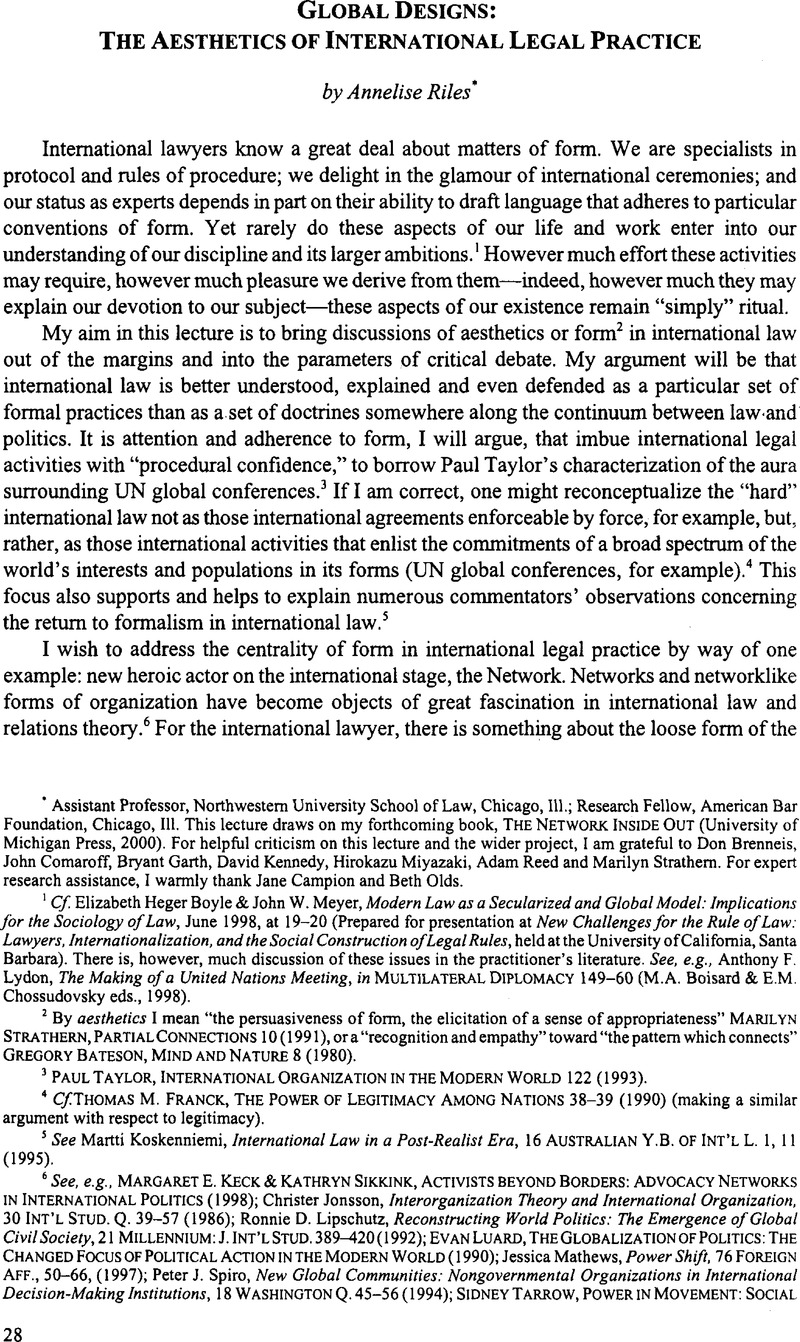Published online by Cambridge University Press: 28 February 2017

* This lecture draws on my forthcoming book, The Network Inside Out (University of Michigan Press, 2000). For helpful criticism on this lecture and the wider project, I am grateful to Don Brenneis, John Comaroff, Bryant Garth, David Kennedy, Hirokazu Miyazaki, Adam Reed and Marilyn Strathem. For expert research assistance, I warmly thank Jane Campion and Beth Olds.
1 Cf. Boyle, Elizabeth Heger & Meyer, John W., Modern Law as a Secularized and Global Model: Implications for the Sociology of Law, June 1998, at 19–20 Google Scholar (Prepared for presentation at New Challenges for the Rule of Law: Lawyers, Internationalization, and the Social Construction of Legal Äufes, held at the University of California, Santa Barbara). There is, however, much discussion of these issues in the practitioner’s literature. See, e.g., Lydon, Anthony F., The Making of a United Nations Meeting, in Multilateral Diplomacy 149-60 (Boisard, M.A. & Chossudovsky, E.M. eds., 1998)Google Scholar.
2 By aesthetics I mean “the persuasiveness of form, the elicitation of a sense of appropriateness” Marilyn Strathern, Partial Connections 10 (1991), or a “recognition and empathy” toward “the pattern which connects” Gregory Bateson, Mind and Nature 8 (1980).
3 Paul Taylor, International Organization in the Modern World 122 (1993).
4 Cf. Thomas M. Franck, The Power of Legitimacy Among Nations 38-39 (1990) (making a similar argument with respect to legitimacy).
5 See Koskenniemi, Martti, International Law in a Post-Realist Era, 16 Australian Y.B. of Int’l L. 1, 11 (1995)Google Scholar.
6 See, e.g., Margaret E. Keck & Kathryn Sikkink, Activists Beyond Borders: Advocacy Networks in International Politics (1998); Jonsson, Christer, ¡nterorganization Theory and International Organization, 30 Int’l Stud. Q. 39-57 (1986)CrossRefGoogle Scholar; Lipschutz, Ronnie D., Reconstructing World Politics: The Emergence of Global Civil Society, 21 Millennium: J. Int’l Stud. 389-420 (1992)CrossRefGoogle Scholar; Evan Luard, The Globalization of Politics: the Changed Focus of Political Action in the Modern World (1990); Mathews, Jessica, Power Shift, 76 Foreign Aff., 50-66, (1997)CrossRefGoogle Scholar; Spiro, Peter J., New Global Communities: Nongovernmental Organizations in International Decision-Making Institutions, 18 Washington Q. 45-56 (1994)CrossRefGoogle Scholar; Tarrow, Sidney, Power in Movement: Social Movements and Contentious Politics, 188-93 (1998)Google Scholar; Moisy, Claude, Myths of the Global Information Village, Foreign Pol’y, 78–87 (Summer 1997)CrossRefGoogle Scholar.
7 For a discussion of the allure of flexibility in contemporary culture, see Emily Martin, Flexible Bodies: Tracking Immunity in American Culture From the Days of Polio to the Age of Aids (1994).
8 See, e.g., William Edward Hall, International Law at 13-34 (1880).
9 For example, one of the networks I studied, Women in Politics (WIP), was funded by the Asia Foundation. The Fiji “focal point” of WIP explained to me that her definition of a network, as opposed to a collective, was an organization accountable only to donors.
10 See, e.g., Thomas Joseph Lawrence, the Principles of International Law 10 (1900).
11 Risen, James, U. S. Says it Has Strong Evidence of Wide-Ranging Terror Network, N.Y. Times, Aug. 21, 1998, at A1 Google Scholar, cited in Riles, infra note 12.
12 Annelise Riles, the Network Inside Out (forthcoming 2000).
13 See, e.g., Slaughter, Anne-Marie, The Real New World Order, 76 Foreign Aff. 183–97 (1997)CrossRefGoogle Scholar.
14 Cf. Berman, Nathaniel, “But the Alternative is Despair”: Nationalism and the Modernist Renewal of International Law, 106 Harv. L. Rev. 1793 (1993)CrossRefGoogle Scholar.
15 See, e.g., Anghie, Tony, Finding the Peripheries: Sovereignty and Colonialism in Nineteenth-Century International Law, 40 Harv. Int’l. L. J. 1 (1999)Google Scholar; Riles, Annelise, Aspiration and Control: International Legal Rhetoric and the Essentialization of Culture, 106 Harv. L. Rev. 723 (1993)Google Scholar.
16 Keck & Sikkink, supra note 6, at 2. Keck and Sikkink argue that “transnational networks” share the following characteristics: “the centrality of values or principled ideas, the belief that individuals can make a difference, the creative use of information, and the employment by nongovernmental actors of sophisticated political strategies in targeting their campaigns.”
17 See Jeremy Bentham, an Introduction to the Principles of Morals and Legislation (Bums & Hart eds., 1970).
18 Keck & Sikkink, supra note 6.
19 Benjamin, Walter, The Work of Art in the Age of Mechanical Reproduction, in Walter Benjamin, Illuminations (Zohn, Harry trans., 1973)Google Scholar (1955).